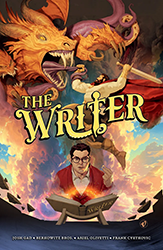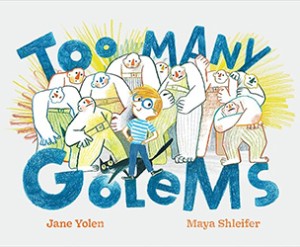Sharing a longtime passion for “sequential Judaica,” Bergson has gathered his treasured findings and solicitations of forty-one graphic renditions of Jewish folklore, plus original stories, into one unique volume. He showcases artists and writers over a span of almost seven decades, from 1946 to 2014. Produced with care on glossy stock, there is a variety of work in full color and black-and-white, with many moods and many styles, including humor, horror, wonder, and wisdom in abstract and literal illustration. Joe Infurnari’s “Workin’Girl Golem” is one page long and tells a story in twenty-four frames with hardly any text; Joe Kubert retells the more well-known medieval Golem story in ten pages (the longest story in the book) and sets it in a 1944 Prague ghetto with many frames and traditional comic text dialogue in each. The majority of tales are adaptations of folklore.
Some meldings of text and design, like Miriam Libicki’s “Flock of Angels,” are given traditional period settings with perky modern dialogue and creative images which open new paths into Talmudic, midrashic, and folk tales and songs. Other stories have been cast in totally new surroundings. Steve Sheinkin’s Rabbi Harvey proves a point to snobs in the Wild West when he feeds their food to his new suit. Nomi Kane’s Ishtar, who would like to be a meteor in the night sky, wears jeans and playfully calls the winged man who comes down from the sky and falls in love with her Captain Kirk. Bergson includes entries by some of the more well-known names — Art Spiegelman, Robert Crumb, Harvey Pekar, and Will Eisner — but reprints and excerpts constitute less than one-third of the book. Many talented women are represented among the newer artists. As for audience, selected comics, such as Art Spiegelman’s “Prince Rooster” may also easily tickle children, but the presence of graphic violent tales, such as the“Chaste Maid” who removes her eyeballs when the city ruler takes her against her will, reserves this anthology for adults and older teens. As in any collection of short pieces, some retellings combine story and art work more successfully than others to capture depth and bring new insights. The arrangement of stories is a mystery when reading straight through, but there is much here to explore and delight.
Related Content:
Sharon Elswit, author of The Jewish Story Finder and a school librarian for forty years in NYC, now resides in San Francisco, where she shares tales aloud in a local JCC preschool and volunteers with 826 Valencia to help students write their own stories and poems.




